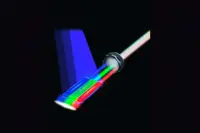 Researchers at Arizona State University claim to have created the first lasers that can shine light over the full spectrum of visible colours. The device's inventors suggest the laser could find use in visual displays, lighting and a laser-based version of Wi-Fi.
Researchers at Arizona State University claim to have created the first lasers that can shine light over the full spectrum of visible colours. The device's inventors suggest the laser could find use in visual displays, lighting and a laser-based version of Wi-Fi.
Previous research has created lasers that usually only emit one colour of light, red, green, blue, etc. Creating a structure capable of emitting red, green, and blue all at once has proven difficult because it requires combining very different semiconductors. Growing mismatched crystals next to one other often results in defects.
But now scientists say they've overcome that problem. The heart of the new device is a sheet, nanometers thick, made of a semiconducting alloy of zinc, cadmium, sulphur, and selenium. The sheet is divided into three segments. When excited with a pulse of light, the segments rich in cadmium and selenium gave off red light; those rich in cadmium and sulphur emitted green light; and those rich in zinc and sulphur glowed blue.
The researchers grew this alloy in stages, carefully varying the temperature and other growth conditions over time. By controlling the interplay between the vapour, liquid, and solid phases of the different materials that made up this nanosheet, they ensured that these crystals could coexist.
The scientists can individually target each segment of the nanosheet with a light pulse. Varying the power of the light pulses that each section received tuned how intensely they shone, allowing them to produce 70% more perceptible colours than the most commonly used light sources.
Lasers are claimed to be more energy-efficient than LEDs: While LED-based lighting produces up to about 150 lumens per watt of electricity, lasers could produce more than 400 lumens per watt, says Cun-Zheng Ning, professor in the School of Electrical, Computer and Energy Engineering, who worked on the laser. In addition, he says that white lasers could also lead to video displays with more vivid colours and higher contrast than conventional displays.
Another important potential application could be 'Li-Fi', the use of light to connect devices to the Interenet. Li-Fi could be 10 times faster than today's Wi-Fi, but "the Li-Fi currently under development is based on LEDs," Ning says. He suggests white-laser based Li-Fi could be 10 to 100 times faster than LED-based Li-Fi, because the lasers can encode data much faster than white LEDs.
In the future, the researchers plan to explore whether they can excite these lasers with electricity instead of with light pulses.
Author
Tom Austin-Morgan
Source: www.newelectronics.co.uk
